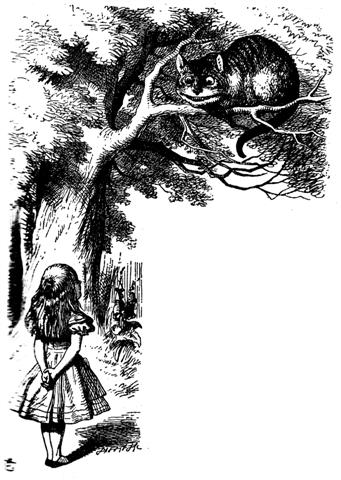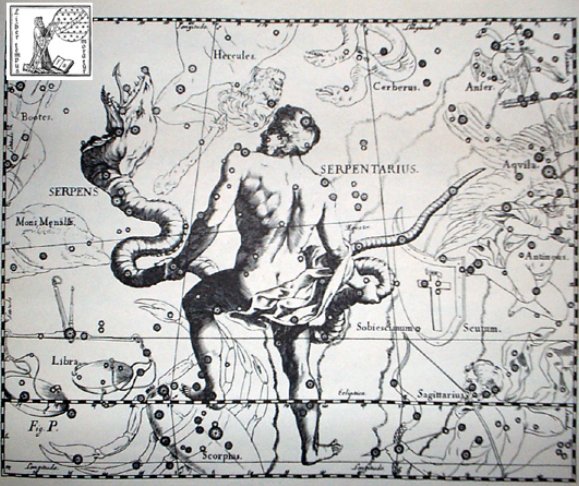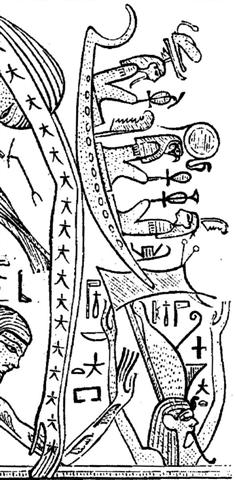Ba5.5
To be 'clawless' is like hiding the hands behind the back, not
to partake in the cycle of life. I.e., to be the opposite of
such creatures as the Chesire Cheese Cat who has 9 life cycles.

|
Egyptian hand |
 |
Phoenician
kaph |
 |
Greek
kappa |
Κ (κ) |
|
Kaph is thought to have been
derived from a pictogram of a hand (in both modern
Arabic and modern Hebrew, kaph means
palm/grip) ...
... The manik,
with the tzab, or serpent's rattles as
prefix, runs across Madrid tz. 22 , the figures in
the pictures all holding the rattle; it runs across
the hunting scenes of Madrid tz. 61, 62, and finally
appears in all four clauses of tz. 175, the
so-called 'baptism' tzolkin. It seems impossible,
with all this, to avoid assigning the value of
grasping or receiving. But in the final
confirmation, we have the direct evidence of the
signs for East and West. For the East we have the
glyph Ahau-Kin, the Lord Sun, the Lord of
Day; for the West we have Manik-Kin, exactly
corresponding to the term Chikin, the biting
or eating of the Sun, seizing it in the mouth.



The pictures (from Gates) show east,
north, west, and south; respectively (the lower two
glyphs) 'Lord' (Ahau) and 'grasp' (Manik).
Manik was the 7th day sign of the 20 and
Ahau the last ... |
We can see how the 'pair of hands' oriented towards the past - at left in the picture
regarding the heliacal Boat (Zaurak) - are returning upside down and
oriented towards the front (ahead) on the other side of Ba5-4,
i.e. turned around 180°.
If this was the effect of a reflection in some kind of mirror it
must be
a concave one because normal flat (or convex) mirrors do not result in
inverted pictures.
 |
 |
 |
 |
 |
 |
|
Ba5-1
(165) |
Ba5-2 |
Ba5-3 |
Ba5-4 (168) |
Ba5-5
(240 - 71) |
Ba5-6 |
|
Rere
toki |
kua huki ko te nuku |
kua tere ko te toki -
toki te henua |
e kua
rere toki |
ki te viriga |
o tona henua |
|
Tere.
1. To run, to flee, to escape
from a prison. 2. To sail a boat (also:
hakatere); tere vaka,
owner of a fishing boat. 3. (Deap-sea)
fisherman; tere kahi, tuna
fisherman; tere ho'ou, novice
fisherman, one who goes deap-sea fishing
for the first time. Penei te huru
tûai; he-oho te tere ho'ou ki ruga ki te
hakanonoga; ana ta'e rava'a, he-avai e
te tahi tagata tere vaka i te îka ki a
îa mo hakakoa, mo iri-hakaou ki te
hakanonoga i te tahi raá. The
ancient custom was like this: the novice
fisherman would go to a hakanonoga;
if he didn't catch anything, another
fisherman would give him fishes to make
him happy so he'd go again one day to
the hakanonoga (more distant
fishing zones where larger fishes are
found). Vanaga. To depart, to run, to
take leave, to desert, to escape, to go
away, to flee, fugitive, to sail, to
row, to take refuge, to withdraw, to
retreat, to save oneself; terea,
rest, defeat; tetere, to beat a
retreat, to go away, refugee;
teretere, to go away, hurrah;
hakatere, to set free, to despatch,
to expel, to let go, to liberate, to
conquer, helmsman; terega,
departure, sailing; teretai, a
sailor. Churchill.
Vere.
1. Beard, moustache (vede
G); vere gutu, moustache;
verevere, shaggy, hairy, tow, oakum.
Mgv.: veri, bristly, shaggy,
chafed (of a cord long in use). Mq.:
veevee, tentacles. Ta.: verevere,
eyelash. 2. To weed (ka-veri-mai,
pick, cut-grass T); verevere, to
weed. P Mgv.: vere, to weed. Mq.:
veéveé, vavee, id. 3.
Verega, fruitful, valuable;
verega kore, unfruitful, valueless,
contemptible, vain, futile, frivolous;
tae verega, insignificant,
valueless; mataku verega kore,
scruple. Mgv.: verega, a design
put into execution; one who is apte,
useful, having a knowledge how to do
things. 4. Ta.: verevere, pudenda
muliebria. Ma.: werewere, id.
(labia minora). Churchill. Sa.:
apungaleveleve, apongaleveleve,
a spider, a web. To.: kaleveleve,
a large spider. Fu.: kaleveleve,
a spider, a web. Niuē:
kaleveleve,
a cobweb. Nukuoro:
halaneveneve,
a spider. Uvea: kaleveleve,
a spider. Mgv.: pungaverevere,
a spider. Pau.: pungaverevere,
cloth. Mg.: pungaverevere,
a cobweb. Ta.: puaverevere,
id. Mao.: pungawerewere,
puawerewere,
puwerewere,
a spider. Ha.: punawelewele,
a spider, a web. Mq.:
pukaveevee,
punaveevee,
id. Vi.: lawa,
a fishing net; viritālawalawa,
a cobweb; butalawalawa,
a spider. Churchill 2.
Viri.
1. To wind, to coil, to roll
up; he viri i te hau, to wind,
coil a string (to fasten something). 2.
To fall from a height, rolling over, to
hurl down, to fling down. Viriviri,
round, spherical (said of small
objects). Viviri te henua,
to feel dizzy (also: mimiro te henua).
Vanaga. To turn in a circle, to clew up,
to groom, to twist, to dive from a
height, to roll (kaviri).
Hakaviri, crank, to groom, to turn a
wheel, to revolve, to screw, to beat
down; kahu hakaviri, shroud.
Viriga, rolling, danger. Viriviri,
ball, round, oval, bridge, roll, summit,
shroud, to twist, to wheel round, to
wallow. Hakaviriviri, to roll, to
round; rima hakaviriviri, stroke
of the flat, fisticuff. P Pau.:
viriviri, to brail, to clew up;
koviriviri, twisting. Mgv.: viri,
to roll, to turn, to twist; viviri,
to fall to the ground again and again in
a fight. Mq.: vii, to slide, to
roll, to fall and roll. Ta.: viri,
to roll up, to clew up. Viritopa,
danger. Mgv.: Viripogi, eyes
heavy with sleep. Mq.: viipoki,
swooning, vertigo. Churchill. Viti:
vili, to pick up fallen fruit or
leaves ... In Viti virimbai has
the meaning of putting up a fence (mbai
fence); viri does not appear
independently in this use, but it is
undoubtedly homogenetic with Samoan
vili, which has a basic meaning of
going around; virikoro then
signifies the
ring-fence-that-goes-about, sc. the
moon. In the Maori, aokoro is the
cloud-fence ... Churchill 2. |
|
May
16 (136) |
17 |
18 (74 + 64) |
19 |
20
(*425) |
21
(141) |
|
MARCH
13 |
3-14 |
15
(74 = 58 + 16) |
16 |
(*361
= 19 * 19) |
18 (442 = 77) |
|
Hairy Head-18 (Cockerel) /
Temennu-3 (Foundation Stone)
ALCYONE
(56.1),
PLEIONE (28 Tauri), ATLAS (27 Tauri)
(56.3) |
MENKHIB (Next to the Pleiades) =
ζ
Persei
(57.6)
PORRIMA (γ Virginis) |
ZAURAK (Boat) = γ Eridani
(58.9) |
λ Tauri (59.3), ν Tauri (59.9) |
4h (60.9)
JĪSHUĬ = λ Persei
(60.7)
COR CAROLI (α Canum Ven.) |
υ Persei
(61.2) |
|
κ
Serpentis (239.3),
δ
Cor. Borealis,
TIĀNRŪ =
μ
Serpentis
(239.5),
χ
Lupi, (239.6),
ω
Serpentis (239.7),
BA (= Pa) =
ε
Serpentis,
χ
Herculis (239.8).
κ
Cor.
Borealis, ρ Serpentis (239.9) |
λ
Librae (240.0),
β
Tr. Austr. (240.3),
κ
Tr. Austr. (240.4),
ρ
Scorpii (240.8)
*199.0 = *240.4 - *41.4 |
Iklīl al Jabhah-15 (Crown of the
Forehead)
/
Anuradha-17 (Following Rādhā) /
Room-4 (Hare) /
Bighanwand
(Clawless)
ξ
Lupi,
λ
Cor. Bor.(241.1),
ZHENG =
γ
Serpentis,
θ
Librae (241.2),
VRISCHIKA = π Scorpii
(241.3),
ε
Cor.
Borealis (241.5),
DSCHUBBA
(Front of Forehead) = δ Scorpii
(241.7), η Lupi (241.9) |
υ
Herculis (242.3),
ρ
Cor. Borealis (242.4),
ι
Cor. Borealis (242.5),
θ
Draconis (242.6),
ξ
Scorpii (242.7)
SCHEDIR (Breast) α Cassiopeiae
*201.0 = *242.4 - *41.4 |
16h (243.5)
ACRAB (Scorpion) = β Scorpii,
JABHAT AL ACRAB (Forehead of the
Scorpion) = ω Scorpii
(243.3), θ Lupi,
RUTILICUS = β Herculis
(243.5),
MARFIK (Elbow) = κ Herculis
(243.7), φ Herculis (243.8) |
ψ
Scorpii (244.6),
LESATH (Sting) =
ν
Scorpii
(244.8) |
|
Clawless
(Clewless) |
|
Nov
15 |
16 |
17
(321 = 3 * 107) |
18 (*242 = 2 * 121) |
19 |
20
(324 = 3 * 108) |
|
SEPT 12 |
13 |
(*177
= 6 * 29½) |
(*178
= *242 - *64) |
16 |
17
(260) |
|
... In
other words, the ancient Druidic religion
based on the oak-cult will be swept away by
Christianity and the door - the god Llyr -
will languish forgotten in the Castle of
Arianrhod, the Corona Borealis. This
helps us to understand the relationship at
Rome of Janus and the White Goddess Cardea
who is ... the Goddess of Hinges who came to
Rome from Alba Longa. She was the hinge on
which the year swung - the ancient Latin,
not the Etruscan year - and her importance
as such is recorded in the Latin adjective
cardinalis - as we say in English 'of
cardinal importance - which was also applied
to the four main winds; for winds were
considered as under the sole direction of
the Great Goddess until Classical times .. |
The stars at the northern spring equinox had due
to the precession shifted the cardinal star points of
the Sun ahead in the year, and
Clawless (clewless, kai viri)

was
currently
visible close to the Full Moon in November 17
(321), instead of in night number 321 - 64 = 257
(SEPTEMBER 14 → 71
* 4 = 284 → 28 * 4 = 168.
According to Hevelius the Sail (Ra) of
Argo Navis had been hoisted up and away from the
pair of 'clew' stars:
|
Suhail al
Muhlif |
|
γ |
λ |
|
Regor |
Roger |
.jpg)
... The substitution of the sun for the sail,
both of which are called ra or raa
in Polynesia, is a remarkable feature in Easter
Island art ...
The beginning of the B text at the
'Gate of the Goat' was 74 right ascension days back in
time-space, and we can therefore count 321
(November 17) - 74 (Haedus I) = 247 (Ba5-9).
|
 |
 |
|
viri |
kai viri |
Probably the hinge at the door to a new year was where cardinal
changes originated.

From this point
(tara) we should be able to move
rather safely ahead in the B text. Below are the
nakshatra stars
which were at the
Full Moon, following 183 days after the stars at the Sun:
 |
 |
 |
 |
 |
|
Ba5-7 |
Ba5-8 |
Ba5-9 |
Ba5-10 |
Ba5-11 (175) |
|
ko te taratu ko te matua kua noho
ki tona nohoga |
i te ragi |
kua rere te toki i ruga o
to manu |
kua rere koe e te toki |
|
Tara. 1. Thorn: tara miro. 2.
Spur: tara moa. 3. Corner; te tara o te
hare, corner of house; tara o te ahu,
corner of ahu. Vanaga. (1. Dollar; moni
tara, id.) 2. Thorn, spike, horn; taratara,
prickly, rough, full of rocks. P Pau.: taratara,
a ray, a beam; tare, a spine, a thorn. Mgv.:
tara, spine, thorn, horn, crest, fishbone.
Mq.: taá, spine, needle, thorn, sharp point,
dart, harpoon; taa, the corner of a house,
angle. Ta.: tara, spine, horn, spur, the
corner of a house, angle. Sa.: tala, the
round end of a house. Ma.: tara, the side
wall of a house. 3. To announce, to proclaim, to
promulgate, to call, to slander; tatara, to
make a genealogy. P Pau.: fakatara, to
enjoin. Mq.: taá, to cry, to call. 4. Mgv.:
tara, a species of banana. Mq.: taa, a
plant, a bird. Ma.: tara, a bird. 5. Ta.:
tara, enchantment. Ma.: tara, an
incantation. 6. Ta.: tara, to untie. Sa.:
tala, id. Ha.: kala, id. Churchill. |
|
CLOSE TO THE
FULL MOON: |
|
χ
Scorpii (245.1),
YED PRIOR (Hand in Front) =
δ
Ophiuchi,
δ
Tr.
Austr. (245.5) |
YED POSTERIOR (Hand Behind) =
ε
Ophiuchi,
RUKBALGETHI SHEMALI (Northern Knee of the Giant) =
τ
Herculis
(246.6).
δ
Apodis (246.7),
ο
Scorpii (246.8) |
Heart-5 (Fox)
σ
Scorpii
(247.0),
HEJIAN =
γ
Herculis
(247.2),
ψ
Ophiuchi (247.7) |
ρ
Ophiuchi (248.1),
KAJAM (Club) =
ω
Herculis
(248.3),
χ
Ophiuchi (248.5),
SHE LOW (Market Tower) =
υ
Ophiuchi,
Tr.
Austr. (248.7), ζ Tr. Austr. (248.8) |
Al
Kalb-16 (The Heart) /
Jyeshtha-18 (Eldest) /
ANA-MUA-1 (Entrance pillar)
ANTARES = α Scorpii
(249.1),
MARFIK (Elbow) = λ Ophiuchi,
φ Ophiuchi (249.5), ω Ophiuchi (249.8) |
|
CLOSE TO THE
SUN: |
|
BEID (Egg) =
ο¹
Eridani
(62.2),
μ
Persei (62.8)
VINDEMIATRIX ( ε Virginis) |
Al Dabarān-2 (The Follower)
HYADUM I =
γ
Tauri (63.4)
*22.0 = *63.4 - *41.4 |
HYADUM II = δ¹ Tauri
(64.2) |
Net-19 (Crow)
AIN
(Eye) = ε Tauri,
θ¹
Tauri,
θ²
Tauri (65.7) |
No star listed (66) |
There was a Hand in Front (in the shadows) followed by a
Hand Behind (out in the light) in Ophiuchus
(Serpentarius):

The Sun was moving through the morning door from his back side to
his front side at the same time as the Serpent dwindled away.
He was shining through at
Ga1-1 at
the time
when the Full Moon was at Kajam, the Club of Hercules.
The Bow of Ship of the Sun moving across the back side of
the earth was caught by a Net (thus forced to 'make landfall') at dawn
(Ba5-10).
... And so they waited there in the
darkness at the place where the sun rises. At length the day
dawned, a chilly grey at first, then flaming red. And the
sun came up from his pit, suspecting nothing. His fire
spread over the mountains, and the sea was all glittering.
He was there, the great sun himself, to be seen by the
brothers more closely than any man had ever seen him. He
rose out of the pit until his head was through the noose,
and then his shoulders. Then Maui shouted, and the
ropes were pulled, the noose ran taut. The huge and flaming
creature struggled and threshed, and leapt this way and
that, and the noose jerked up and down and back and forth;
but the more the captive struggled, the more tightly it
held. Then out rushed Maui with his enchanted weapon,
and beat the sun about the head, and beat his face most
cruelly. The sun screamed out, and groaned and shrieked, and
Maui struck him savage blows, until the sun was
begging him for mercy. The brothers held the ropes tight, as
they had been told, and held on for a long time yet. Then at
last when Maui gave the signal they let him go, and
the ropes came loose, and the sun crept slowly and feebly on
his course that day, and has done ever since. Hence the days
are longer than they formerly were. It was during this
struggle with the sun that his second name was learned by
man. At the height of his agony the sun cried out: 'Why am I
treated by you in this way? Do you know what it is you are
doing. O you men? Why do you wish to kill Tama nui te ra?'
This was his name, meaning Great Son of the Day, which was
never known before ...
There was no significant Full Moon star in the next night,
and
in Ba5-11 the bird is looking up and back (he had no future)
- and
his staff (club) is broken, we can see. The 3 islets outside the
southwestern (toga) corner of Easter Island were not sons of Taraga
but sons of Taaga.
Toga. 1. Winter
season. Two seasons used to be distinguished in ancient
times: hora, summer, and toga, winter. 2. To
lean against somehing; to hold something fast; support, post
supporting the roof. 3. To throw something with a sudden
movement. 4. To feed oneself, to eat enough; e-toga koe
ana oho ki te aga, eat well first when you go to work.
Vanaga. 1. Winter. P Pau., Mgv.: toga, south. Mq.:
tuatoka, east wind. Ta.: toa, south. 2. Column,
prop; togatoga, prop, stay. Togariki,
northeast wind. Churchill. Wooden platform for a dead
chief: ka tuu i te toga (Bb8-42),
when the wooden platform has been erected. Barthel 2. The
expressions Tonga, Kona, Toa (Sam.,
Haw., Tah.), to indicate the quarter of an island or of the
wind, between the south and west, and Tokelau,
Toerau, Koolau (Sam., Haw., Tah.), to indicate
the opposite directions from north to east - expressions
universal throughout Polynesia, and but little modified by
subsequent local circumstances - point strongly to a former
habitat in lands where the regular monsoons prevailed.
Etymologically 'Tonga', 'Kona', contracted
from 'To-anga' or 'Ko-ana', signifies 'the
setting', seil. of the sun. 'Toke-lau', of which the
other forms are merely dialectical variations, signifies
'the cold, chilly sea'. Fornander.
*65 (the Eye, Ain) + 80 = 145 (May 25) and
145 - 64 = 81 (MARCH 22) = 264 (SEPTEMBER 21, Kajam
*184) - 183. And 8 days later was Cujam (as if to
announce the beginning of the Morning Star days):
|
KAJAM (*248) |
CUJAM (*256) |
|
ω
Herculis |
ε Herculis |
|
Egyptian
jubilation |
 |
Phoenician
he |
 |
Greek
epsilon |
Ε (ε) |
|
Wikipedia points at the
Egyptian gesture with arms held high as a
Sign of jubilation, which may have been the
origin (via Phoenician he) of
epsilon.

 |
|
SYNODIC CIRCUIT OF VENUS |
|
Black |
8 |
|
Morning Star |
263 |
|
Black |
50 |
|
Evening Star |
263 |
|
Sum |
584 |

|





.jpg)








